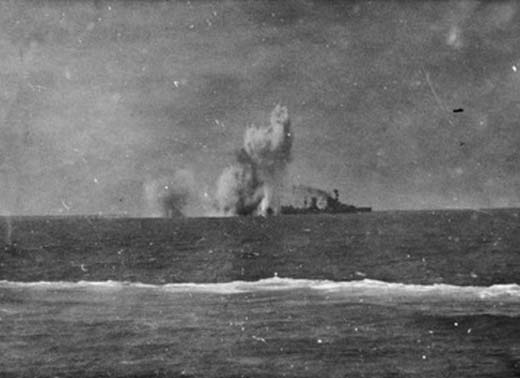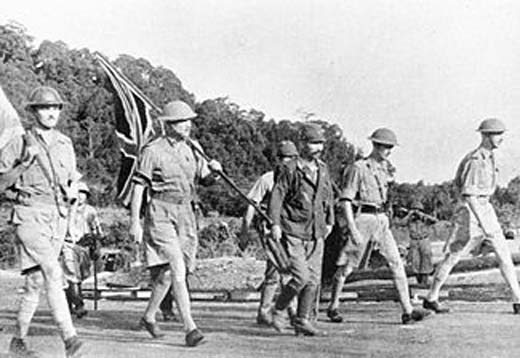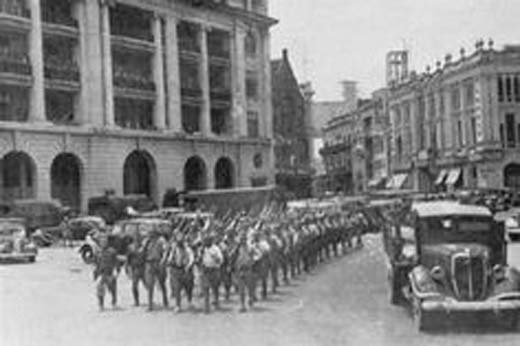Battle of the Atlantic
- The Brazilian ship Buarque (5152t) is sunk by U-432 30 miles off Cape Henry on the American east coast with the loss of 1 on board. 84 survivors are picked up at different times by the American coast guard cutter Calypso (47), the American destroyer Jacob Jones (16) and the American patrol craft Eagle (21).
- U-98 sinks the British steamer Biela (5298t), from dispersed Convoy ON-62, 400 miles southeast of Cape Race with the loss of all 50 crew members.
- U-566 sinks the Greek steamer Meropi (4181t), a straggler from Convoy ON-60, 35 miles east-southeast of Sambro Lighthouse, Nova Scotia with the loss of 24 of her crew. 15 survivors are picked up by the Canadian corvettes Sherbrooke and Barrie.
Britain, Home Front
Mrs Churchill's Red Cross Fund for Russia reaches 1.5 million pounds.
[Burma
Because the Japanese are now over the Salween in force, the outpost units of 17th Indian Div abandon Thaton and are pulled back west of the Bilin River.
[Dutch East Indies
The Japanese forces attacking Palembang receive reinforcements via an invasion fleet and compel the garrison to retreat before they have finished destroying the great oil refinery.
An Allied convoy sails from Darwin, in northern Australian, with reinforcements for Kupang on the island of Timor. The object of the mission is to occupy Penfoie airfield, the only airfield on Timor which could be used for operations against the Japanese in Java.
Thai Aircraft Bombing Dutch Cruiser |
 |
Allied forces on Sumatra are ordered to the west coast for evacuation.
[Eastern Front
NORTHERN SECTORIn a bold attempt to bring about a decisive decision in the Demyansk pocket, the Soviets drop paratroopers behind the German line. The Germans, however, bring heavy fire to bear, inflicting terrible casualties. Virtually the entire force is lost and the few who do survive the landing are captured.
CENTRAL SECTORSoviet forces on the Moscow axis have been substantially reinforced during the first half of February. The Kalinin Front receives 7 new rifle divisions, a guards rifle corps and 4 air regiments, while the West Front takes over 60,000 men into its ranks, 3 rifle divisions, 1 guards rifle corps and 2 parachute brigades. In line with the developing offensive, Zhukov issues a new set of directives to the forces of Glavkom West. The Kalinin Front is to capture the Olenino region with the 22nd, 30th and 39th Armies, destroying the German 9th Army. The West Front is to attack with its 43rd, 49th and 50th Armies, taking Yukhnow, and 16th and 61st Armies are to capture Bryansk. At the same time, the IV Airborne Corps is to complete its drop in the Yukhnow area to threaten the rear of the German 4th Army. The 50th Army is to support the airborne forces, attacking toward Yukhnow.
At the front, Group Sinzinger comes under fierce attack while new Soviet attacks push toward Surazh.
[Indian Ocean
I-65 sinks the British steamer Johanne Justesen (4681t) off the west coast of India with the loss of 1 crewman. There are 58 survivors.
[Pacific
The British auxiliary anti-submarine ship Mata Hari is sunk by Japanese gunfire at Banka. 15 of the crew are make prisoners of war.
[Philippines
In the II Corps area, the Japanese attack in limited strength to ease the pressure against troops withdrawing northward from the I Corps sector. The I Corps continues to make steady progress against the salient in their main defense line.
[ Lt-Gen Percival Under Flag of Truce |
 |
Singapore
The Allied forces are now confined into a small area around Singapore town. Certain categories of ammunition are in short supply and there is little water because the Japanese hold the reservoir area. Gen Percival had been directed to fight as long as possible but was given discretion in determining when further resistance was futile. He decides to seek terms. He personally meets with Gen Tomoyuki Yamashita, commander of the Japanese 25th Army. At 7:50p.m. local Gen Tomoyuki Yamashita accepts Gen Percival's surrender. The surrender is unconditional, and takes effect immediately. The capture of the rich Malayan peninsula and the fortress described as the 'Gibraltar of the East' has cost the Japanese 9,824 men. The total Allies casualties are 67,340 Indian, 38,496 British, 18,490 Australian and 14,382 local volunteer troops. Of a total of 138,708, almost 130,000 are prisoners. Japanese forces have been far better trained and led, and have had the crucial advantages of overwhelming air power and the few tanks present. They have expected to complete the campaign in 100 days; they have taken 70. The Malayan campaign has been the greatest disaster in British military history. (Summary)
Victorious Japanese Troops March Through Singapore |
 |